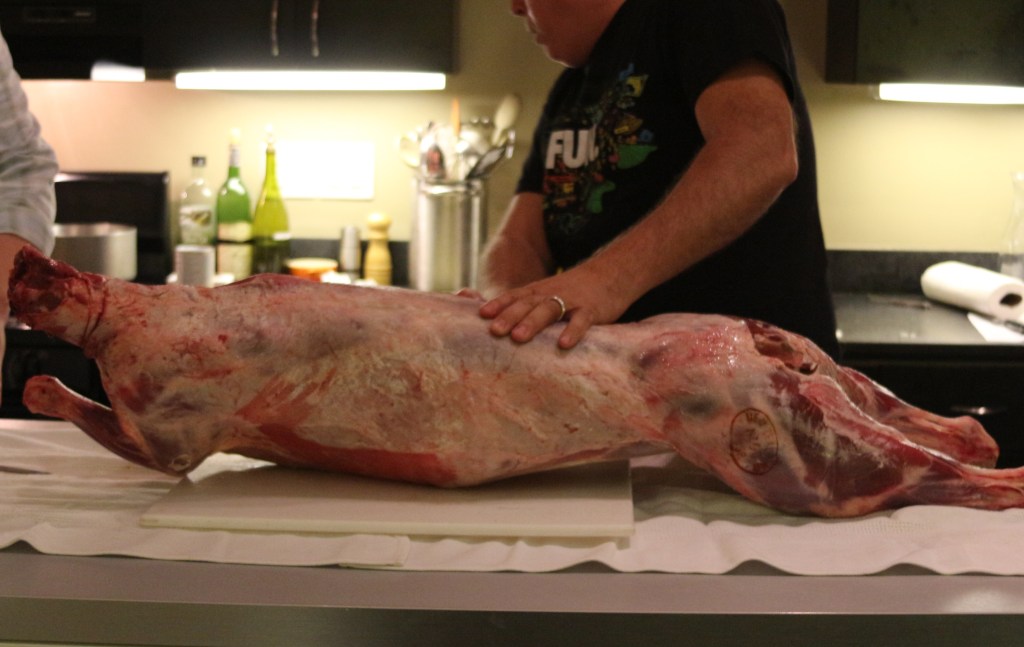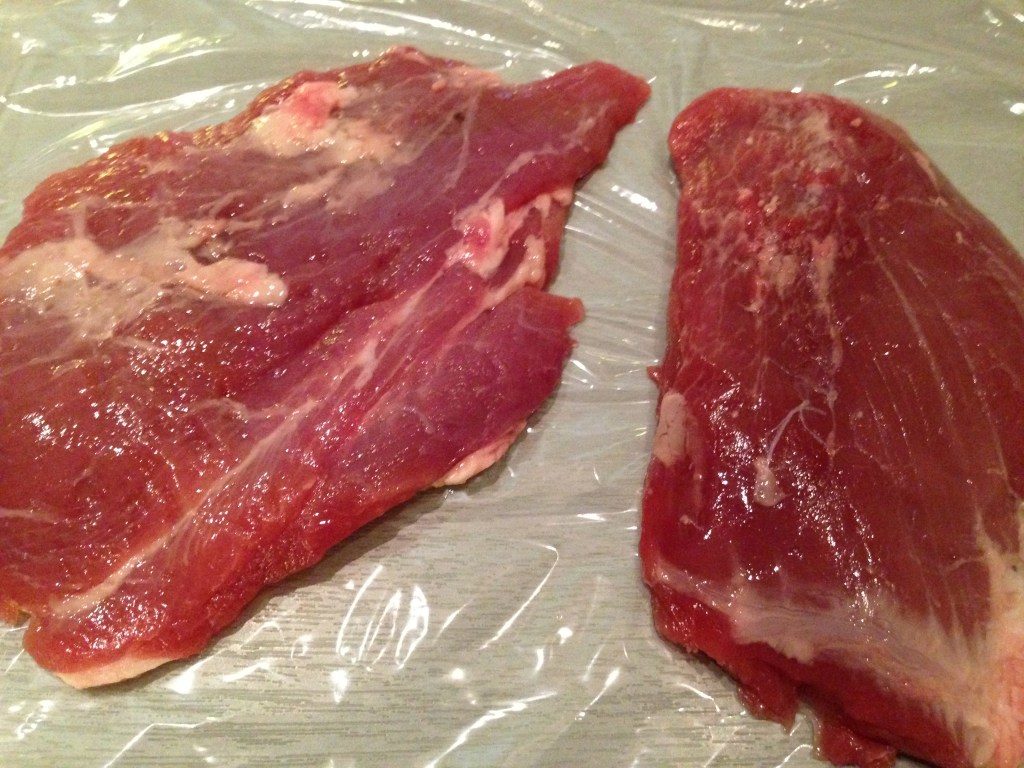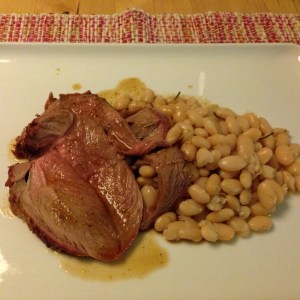Almost six months ago I celebrated my birthday by cutting up the carcass of a lamb. That might not be everybody’s idea of a good time but I had fun with it and learned a lot. The more you understand food in its pre-supermarket stages, the better able you are to cook it well.
I documented my dissection of the lamb and committed likewise to describing later what I did with the various components, but in that task I fell short. Oh, it was all cooked and consumed but I most often forgot to take notes or pictures until the plate was clean. What follows is mostly from memory:
On the night of the butchery – butchering? butcherage? butcheration? – I put some trim pieces and bits from the breast through the grinder and made a ragù, which was quite delicious over pasta. I forget what kind of pasta we used but doubt that that’s especially significant for today’s purposes. I am certain, however, that it was neither capellini nor ziti since I never buy capellini or ziti and wouldn’t have had any on hand, unless, that is, someone had given us some as a gift, but that hadn’t happened so I know it wasn’t capellini or ziti over which I spooned my delicious lamb ragù. In all likelihood it was spaghetti or fettuccine since spaghetti and fettuccine are the pasta varieties I buy most often, but as I write this I’m more and more sure that it was not capellini or ziti. Aside from the fact that I almost never buy capellini or ziti and therefore wouldn’t likely have had any in the house, putting a hearty meat sauce on something as delicate as capellini just isn’t done in the more sophisticated pasta circles. One could put a lamb ragù on ziti but I absolutely never buy ziti. It was spaghetti or fettuccine – one of those, I’m pretty sure.
A few days later, on the occasion of my birthday, I served lamb four ways. First there was a cold terrine: lamb shoulder ground coarse, seasoned, and cooked in a rectangular ceramic dish, then chilled. We served slices of it with a little salad and some cornichons.
Then came three preparations on one plate: first tiny pink chops cut from the racks, which I’d roasted; then slices of one of the legs, which I’d deboned, butterflied, seasoned with rosemary and garlic, and grilled; then ravioli of ground lamb with peas. Here are the ravioli, along with a picture of some aluminum foil that I assume covered the racks before I cut them into chops. I assume this because of the position of the picture of foil in my iPhoto inventory, where it occurs immediately after the picture of ravioli, just as it does here. I don’t know why I took a picture of aluminum foil.
The food was well received by the guests and I heard many compliments, but it’s worth noting that a) it was my birthday, and b) the guests had not been asked to pay for their food, so those factors might have played a part in the generous praise they lavished upon me.
A week later I made schnitzel from the two lamb flanks. The animal was small – only about 27 pounds when I bought it – so the flanks were also small. Each made a serving. The schnitzel process is well known so I won’t go into it here except to say immodestly that I make schnitzel often and I am very good at it. One sees it made with veal, of course, and chicken and pork – I’ll even make it with salmon fillets now and then – but lamb isn’t such a common schnitzel subject. It turned out to be quite an excellent dish and I would make it again if I were ever to find myself with some lamb flanks. It could also work with lamb breast if the animal were big enough. (Mine wasn’t.) That’s herbed spaetzle on the plate, by the way, and some spinach. And in the upper right corner is a lemon wedge.
As I was thinking about schnitzel just now I was curious to know the origin of the word itself, so I looked it up. It turns out to derive from any or all of the following: schnitt, sniz or snitz, and schneiden, all of which mean “cut” or “slice,” either as noun or verb. This information turned out to be rather less captivating than I hoped.
The parts of the lamb I was most looking forward to cooking were the little loin and tenderloin muscles. Think for a minute about beef, particularly a T-bone or Porterhouse steak. There’s a long piece of meat on one side of the bone and a smaller piece of much tenderer meat on the other side of the bone. The muscles from which these steaks are cut, if removed from the animal intact instead of being sliced into steaks, are the top loin, or Longissimus Dorsi, and the tenderloin, or Psoas Major. (Someday someone will ask you if you know this, and I hope you’ll remember at that moment where you learned it.)
Keep in mind that we’re still talking about beef for the time being because most of us are more familiar with cuts of beef than with cuts of lamb. But now imagine that T-bone steak miniaturized to a twelfth its size, and what you have is a lamb loin chop. The muscles, by the way, bear the same names as on their bovine cousins. Lamb loin chops are flavorful, delicious and easy to cook. In stores they’re quite expensive. I did not make loin chops from my lamb. To do that would have required much sawing, the prospect of which interested me not at all. Here is one of the two little loins, positioned on me approximately where it would appear if I were a 180-pound lamb.
I removed the two loin and tenderloin muscles – one of each on either side of the spine – and saved them for a special meal.
I neglected to take any pictures of these jewels as I cooked or ate them, but be assured that, seasoned and sautéed in butter and doused with Béarnaise sauce, they lived up to their potential and my expectations.
There was another pound of ground lamb in the freezer, and I turned that into more sauce for pasta, or maybe a shepherd’s pie. I can’t remember.
There was also a pair of shanks, which I braised.
That left only a leg, and quite a lovely leg of lamb it was.
I imagine that people have come up with all manner of treatments they expect will improve lamb legs. I don’t doubt that people have injected them with Fresca and smeared them with marshmallow, but I “went all traditional” with my lamb leg, applying only salt, pepper, garlic and rosemary to it, and then roasting it at several hundred degrees for a while.
Such an impressive joint needed little in the way of accompaniment, so I cooked some white beans with garlic. We opened a bottle of Burgundy.
The hind leg of even a small lamb will provide a bounty of meals. After I roasted it on the 7th – that’s when I roasted it, March 7th of this year – there were cold sandwiches to be had, and then a shepherd’s pie made from meat I cut from the leg and chopped. Here is a most unappealing picture of the shepherd’s pie.
And still we weren’t finished!
I made broth from the bones, picked off the remaining meat, and turned it into soup with the leftover beans.
I believe it’s safe to say that we made the most of my birthday lamb. We extracted many meals and much pleasure from him.
Finally, after giving it some more thought, I am now absolutely certain that our first lamb ragù was served over spaghetti or fettuccine versus some other shape of pasta. Absolutely.














